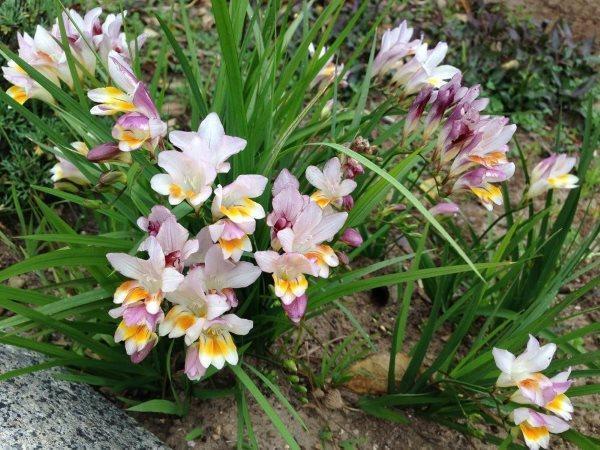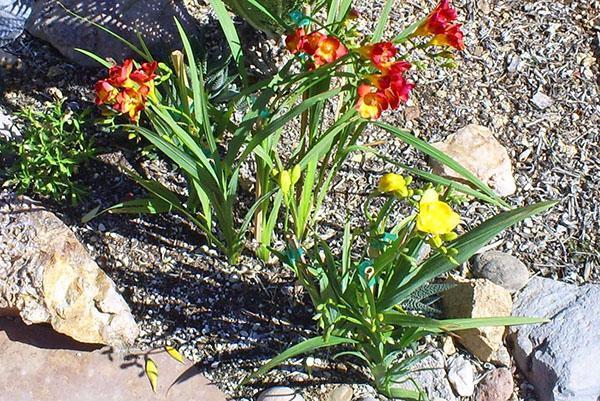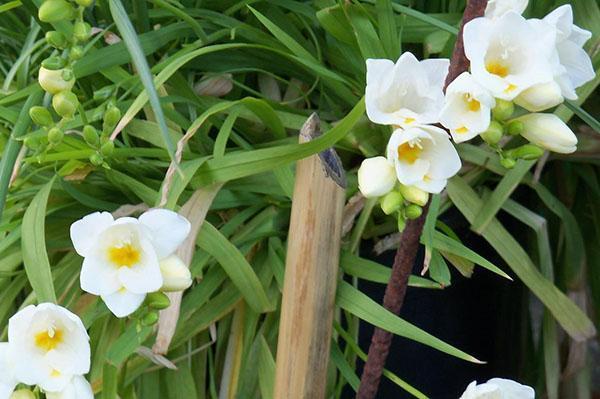The most important thing about planting and outdoor care for delicate freesia
 Thanks to the fragrant flowers of various colors, freesia has become one of the most valuable corms for cutting. It is not surprising that freesia, planting and care in the open field for which is akin to taking care of gladioli and lilies, increasingly appears in summer cottages.
Thanks to the fragrant flowers of various colors, freesia has become one of the most valuable corms for cutting. It is not surprising that freesia, planting and care in the open field for which is akin to taking care of gladioli and lilies, increasingly appears in summer cottages.
Features of growing freesia in the open field

- with a day of light lasting at least 12-14 hours;
- in the presence of protection from direct sunlight and wind;
- at an air temperature within 18-22 ºC.
Violations of light and temperature conditions, long periods of heat and drought, lead to the formation of empty, non-opening buds on freesia or a complete rejection of flowering.
The place for planting is chosen so that the brittle stems of the plant do not suffer from the wind, and the delicate flowers do not burn the summer sun. Already at an air temperature above +22 ºC, the biological rhythm of the plant is disrupted, and this affects the quality of flowering.
When grown outdoors, freesias are better acclimatized in soil with neutral or slightly acidic reactions. In areas with heavy, dense soil, it is deacidified and mixed with sand, peat... Soils poor in organic matter and minerals must be fertilized.
Plants are not hardy. In Russia, they must be dug up for the winter, and taken out into the ground when the threat of return cold and frost on the soil has passed. If planting in the ground takes place in May or early June, freesia bloom begins from the second half of July to the end of August. However, this is only valid for the middle lane. To see freesia flowers when planting and nursing in Siberia, not bulbs are transplanted into the ground, but plants already grown in a room or greenhouse.
Preparing a site for planting freesia in open ground in spring

The site for planting freesia is chosen in partial shade or under protection, planted on the south side of tall shrubs or trees. Such a natural barrier will save flowers from the wind and midday sun.
In the fall, the soil for planting freesia is dug up on a full bayonet, carefully choosing perennial rhizome weeds. At the same time, organic fertilizers are applied to the ridges or flower garden. In the spring, the soil is dug up again, breaking up clods. Planting pits or trenches for bulbs are made about 30–40 cm deep and wide. Although the planting depth is much shallower, filled with a loose pit, consisting of equal parts of garden soil, peat, humus and sand, will allow the root system and the entire plant to develop actively.
Preparing freesia bulbs for outdoor cultivation
 Bulbs purchased or stored after the autumn digging begin to be prepared for planting in early April. They remove the hard surface skin, and then immerse it in a solution of phytosporin or another fungicide for half an hour. This precaution will keep the bulbs free from rotting bacteria and fungi in the soil.
Bulbs purchased or stored after the autumn digging begin to be prepared for planting in early April. They remove the hard surface skin, and then immerse it in a solution of phytosporin or another fungicide for half an hour. This precaution will keep the bulbs free from rotting bacteria and fungi in the soil.
30–45 days before the time for planting freesia outdoors in the spring, the bulbs are placed in deep peat pots filled with nutrient soil. The planting depth is 5 cm, the substrate is lightly tamped and then watered.With high humidity, freesia will soon wake up and form the first shoots. Now is the time to transfer the bulbs to the light.
It is important that the sprouts do not stretch out before hitting the ground, they are dense and healthy. Therefore, if necessary, the plants are provided with additional lighting.
Planting freesia seeds
 Like many related species, freesias can be propagated by seed. At least 8-9 months should pass from the moment of sowing to the appearance of the first buds. If you plant freesias in the ground in the fall, in the spring, plants that have already gained strength are taken out into the garden.
Like many related species, freesias can be propagated by seed. At least 8-9 months should pass from the moment of sowing to the appearance of the first buds. If you plant freesias in the ground in the fall, in the spring, plants that have already gained strength are taken out into the garden.
Sowing is carried out with seeds pretreated with potassium permanganate or phytosporin to a depth of 3-4 mm. The best results can be achieved in a home greenhouse, where it is easier to maintain increased soil and air humidity. Until shoots appear, the soil is moistened with a spray bottle. Then accurate watering is possible and irreplaceable in the autumn-winter period backlight... Planting and caring for freesias outdoors is no different than caring for plants from adult bulbs.
Planting freesia and outdoor care
 The conditions for planting freesia on a flower bed in regions with excellent climatic features develop at different times. In the middle lane and in the Moscow region, planting freesia in the ground and caring for plants begins in mid-May.
The conditions for planting freesia on a flower bed in regions with excellent climatic features develop at different times. In the middle lane and in the Moscow region, planting freesia in the ground and caring for plants begins in mid-May.
If there is a chance of frost, it is better to leave delicate plants at home for a couple of weeks.
The bulbs are planted at a distance of 3-5 cm from each other. Freesias do not form a lush bush, therefore, for a greater decorative effect in a flower garden, they can be planted in small clumps of 10–15 pieces, not forgetting to provide the stems with reliable support.
To simplify outdoor care when planting freesias for cutting, leave at least 15 cm between the rows.
 The planting depth of the bulbs depends on their size and soil properties.
The planting depth of the bulbs depends on their size and soil properties.
- On light sandy loam, freesia are buried 10-12 cm.
- On loose fertile garden soil, the bottom of the bulb should be at a depth of 7-9 cm.
- In dense soil, freesia is most difficult to root and sprout. Here, the bulbs are planted to a depth of 5–6 cm.
Care for freesia when grown in the open field
 From the moment of planting to digging the bulbs in the fall, flowers need watering, loosening the soil, removing weeds and complex fertilizing.
From the moment of planting to digging the bulbs in the fall, flowers need watering, loosening the soil, removing weeds and complex fertilizing.
Due to the fragility of the bare stems carrying a mass of buds, supports must be provided for freesias.
It would seem that such care is practically indistinguishable from caring for lilies, irises, gladioli. But growing freesia, like caring for it in the open field, is fraught with some difficulties.
The fact is that freesia blooms only at temperatures below +22 ºC. So that leaves and flowers do not suffer from a lack of moisture, the air must be constantly humid; it is extremely difficult for plants to tolerate sharp fluctuations in day and night temperatures. Because of these features, the flower is more often grown in greenhouses or under greenhouses.
In the open field, freesias are regularly irrigated with warm water in the evening hours, trying not to get on flowers and buds that have not yet opened. Watering begins immediately after germination and ends 2 weeks before the bulbs are dug.
For fertilizing flowers, you can use complex fertilizers for ornamental flowering plants or, before flowering, add a mixture with a predominance of nitrogen, and use it closer to the middle of summer potassium-phosphorus facilities.
In order for the bulbs to ripen better, and the plant to bloom again, the wilted ones are cut off one by one or in groups. For bouquet cutting, inflorescences with two or more open corollas are suitable. Leaves damaged by fungi or pests can be shortened or removed. The bulbs are harvested in the fall, from September to October, before the arrival of night frosts.